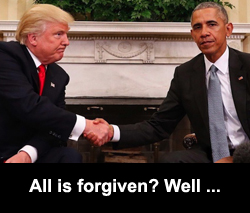You’ve already heard enough about Tuesday’s election, I know. My feeling since that night has been pretty much, the struggle continues – move on. I’ll take a few moments, though, to share a few thoughts about Trump’s win.
First, this was a low turn-out election, plain and simple. Though Clinton won the popular vote by about 400,000 ballots Tuesday night, she received about six million fewer votes than Obama did in 2012. Trump received a million less than Romney’s 2012 totals. Some of that difference can be attributed to turnout in large states like California, but many of the swing states – Michigan, Wisconsin, Ohio, for instance – were significantly down from 2012. People did not show up to vote for either party, but their absence was most keenly felt by the Clinton campaign, which was trying to call out the Obama coalition and failed miserably. So don’t let anyone tell you this was a historic groundswell of support for Trump – far from it. He under-performed his party’s unsuccessful (and notoriously uninspiring) candidate from 2012.
 Second, there’s some reason to believe that Trump’s success, in the absence of a traditional ground GOTV campaign, was based in large measure on free media in the form of speeches and appearances that ran on practically every news channel for hours a week over the last year. I have heard NBC reporters (sometimes referred to as “journalists”) connect this Trump phenomenon with the large number of Trump signs they saw in rural communities. That, of course, was just a symptom of the mental disease that afflicts non-rich Trump supporters. The vector by which the disease spread was their own “reporting” – namely, serving up hours of this man’s bullshit on multiple platforms to millions of hungry minds, hence the signs. But they are no more reliable an indication of the level of support than the number of people showing up at Trump rallies. Sure, he had large crowds. So did Bernie. So did Ralph Nader in 2000. When the day came, the numbers were pretty flaccid.
Second, there’s some reason to believe that Trump’s success, in the absence of a traditional ground GOTV campaign, was based in large measure on free media in the form of speeches and appearances that ran on practically every news channel for hours a week over the last year. I have heard NBC reporters (sometimes referred to as “journalists”) connect this Trump phenomenon with the large number of Trump signs they saw in rural communities. That, of course, was just a symptom of the mental disease that afflicts non-rich Trump supporters. The vector by which the disease spread was their own “reporting” – namely, serving up hours of this man’s bullshit on multiple platforms to millions of hungry minds, hence the signs. But they are no more reliable an indication of the level of support than the number of people showing up at Trump rallies. Sure, he had large crowds. So did Bernie. So did Ralph Nader in 2000. When the day came, the numbers were pretty flaccid.
So there was no phenomenal groundswell on either side. The warning signs for the Democrats were apparent during the primary season, when voter turnout was relatively low. There has obviously been an enthusiasm gap, but that is a failure of organizing – we need to work harder to convince people of how vital it is to vote as a means of advancing policy goals, not as some kind of rough demonstration of your values. We may never know why tens of thousands of Democratic voters in key swing states – people who put Obama over the top twice – didn’t show up last Tuesday. There are no exit polls on no-shows. But it places in stark relief the fundamental injustice of our presidential elections, which value some voters over others. There is no justification for not having one-person, one-vote nationwide; we no longer need the training wheels of the electoral college. Pundits are fond of describing our presidential elections as a series of 50 different elections, but if that were the case, the winner would be president of only those states that supported him/her.
The presidency is a national office: as Americans, we should all have an equal say in who holds it. If you agree, find one of the petitions circulating for abolishing the electoral college and sign it.
Next week: The consequences of Nov. 8, 2016 (part I).
